Total Solar Eclipse: 2006 March 29
Out into the Libyan Sahara Desert with |
 |
| Site Location (WGS 84) Longitude: 21 deg. 30 min. 14.3 sec. East Latitude: 28 deg. 14 min. 16.0 sec. North Predicted
Contact times (mean limb, Occult
v3.6) |
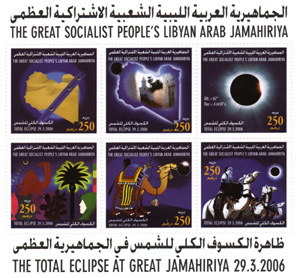 |
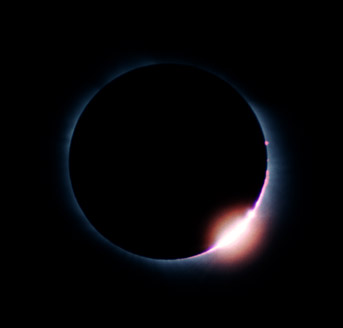
Diamond Ring at 3rd Contact
Celestron C90, Kodachrome 64
Aram Kaprielian has kindly linked the TQ webpages to mine, so here is the reverse link: http://www.travelquestinternational.com/TourReports/Eclipse2006/Eclipse2006Links.htm
It is not straightforward to visit to Libya, so we joined a tour organised by the American travel company TravelQuest in association with Sky and Telescope
Report
The morning of eclipse day dawned clear and
sunny and we headed out into the desert to find an
observation site away from the camp with a good
360-degree horizon. As the Sun climbed higher into the
Saharan sky, anticipation mounted and more people
wandered out into the sand. During the morning a fairly
moderate breeze blew across the desert; one or two dust
devils took off from nearer the camp. Five minutes before
totality someone close by spotted Venus in the darkening
sky and the wind seemed less strong. A minute or so
before totality and the shadow bands appeared flickering
across the sand; then the shadow was upon us, the last
speck of photosphere disappeared behind the Moon and the
corona, chromosphere and prominences sprang into view.
Through binoculars the view was stunning - the corona was
typical of solar minimum with delicate 'brushes'
emanating from the polar regions and longer plumes along
the equator. Mercury could be seen between the Sun and
Venus, and it seemed as though it was sunset arond the
entire horizon. All too soon, the chromosphere appeared
from behind the limb of the Moon, a magnificent diamond
ring shone forth, rapidly became double, and the full
intensity of the photosphere was back. Along the
north-eastern horizon the darkness lingered for a while
and Venus hung on a bit longer.
Just before sunset, a number of people made their way to the western side of the camp to watch the Sun disappear across the desert sand. As the last speck sank below the horizon there was just a hint of green - not a specatacular 'green flash', but just enough to round off a perfect day and earn a round of applause from the appreciative onlookers.
Thermochrons
Once again, the thermochrons were deployed at the eclipse
site. This time they were attached to the tent, about 200 metres away from the
where we observed the eclipse. One was buried under a
centimetre or two of sand, one was 30 centimetres above
ground level and the third was a bit higher at about 1
metre above ground (closeup).
The two devices measuring the air temperature were
shielded from the Sun by card 'sunshades'. The graph is here, but in summary, the
ground temperature dropped by 5 degrees Celsius with a
lag of half-an-hour from the eclipse times. The air
temperature at 30cms dropped by 14 degrees Celsius with a
lag of about 6 minutes and the temperature at 1 metre
dropped by 12.5 degrees Celsius with a lag of 3 minutes.
Thanks to the thermal characteristics of the desert
environment, these are the clearest results we have
obtained.
The overnight low recorded by the devices was 10.5 degrees Celsius between 04:00hrs. and 04:30hrs. UTC (6.00 - 6.30am local time).
Nick Quinn & Linda Croft
Follow the link to pictures of Western Libya and Ghadames.
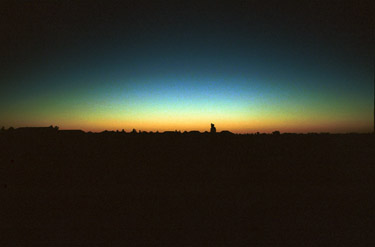
Beautiful colours around the horizon during totality.

Bob Silvey - mobile pinhole camera (click on image for closeup view of 'crescent suns').
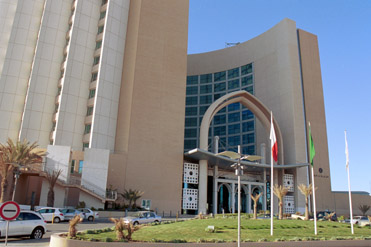
From the Hotel Corinthia Bab Africa to ...
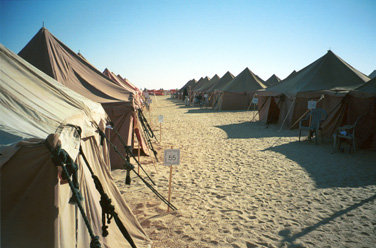
1st class accommodation in the desert!
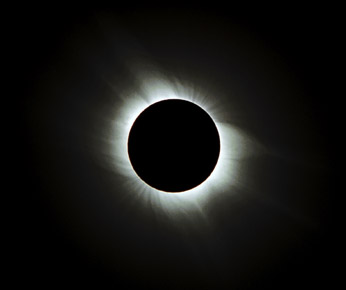
Corona taken with Canon T70 attached to Tamron 500 f/8 mirror lens on Kodak Elite 200 colour negative film.
